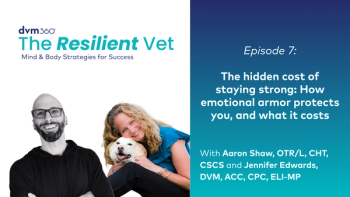
Approach to the bleeding patient (Proceedings)
The bleeding patient is one of the more common emergency cases presented to veterinary hospitals. Although management of these cases is often initially symptomatic, it is imperative for the veterinary team to understand the diagnostic tests available to investigate the underlying etiology.
The bleeding patient is one of the more common emergency cases presented to veterinary hospitals. Although management of these cases is often initially symptomatic, it is imperative for the veterinary team to understand the diagnostic tests available to investigate the underlying etiology. Once the underlying disease is identified definitive therapy can be provided. The following discussion will review the available diagnostic procedures for identifying the bleeding patient and therapy that is required.
Activated coagulation time (ACT)
The activated coagulation time is a quick and easy cage side test. The test traditionally has been performed using a Vacutainer with siliceous earth. The siliceous earth acts as an activator to shorten the coagulation time. The test requires two milliliters of whole blood, which is drawn or placed into a warmed Vacutainer. The tube is inverted several times until the sample is completely mixed and then placed on a heating block for 1 minute. After the minute has elapsed the tube should be gently tilted every 5 seconds in order to observe clot formation. The end point is the first sign of clot formation. Normal values for the dog are less than 120 seconds. This test will detect deficiencies in the intrinsic and common pathways. The test may be affected by severe thrombocytopenia and thrombocytopathy.
Although automated instruments such as the iSTAT (Heska) are available for measuring ACT, newer instruments (Synbiotics SCA-2000) offer the measurement of PT and PTT which may eliminate the need for the ACT.
One stage prothrombin time (OSPT)
The PT test is a very sensitive test and in many cases needs to be sent to an outside laboratory. But as mentioned above the SCA2000 can perform the prothrombin time on whole blood or EDTA blood. This test is designed to evaluate the extrinsic pathway and common pathway. This test is primarily used for evaluation of Factor VII, which has the shortest half-life of the vitamin K dependent factors (~ 6 hours). This test is generally performed on citrated blood.
Activated partial thromboplastin time (APTT)
The PTT test is used to evaluate the intrinsic and common pathways and is similar to the ACT, however much more sensitive. It is commonly run in conjunction with the PT and is generally run on citrated whole blood. Deficiencies in Factors VIII and IX (Hemophilia A/B) are the most common abnormalities detected. The PTT must be interpreted along with the PT and FDP's for the diagnosis of disseminated intravascular coagulopathy (DIC).
Proteins Induced by Vitamin K Antagonism (PIVKA)
This test has been advocated for use in diagnosing vitamin K antagonist rodenticide intoxication. This test is able to measure inactive precursors of the vitamin K dependent coagulation factors (II, VII, IX, X). It appears that the PIVKA test is prolonged earlier than the PT and PTT in rodenticide intoxication cases. However other diseases, which lead to a relative vitamin K deficiency, will also lead to a positive PIVKA test.
Fibrin degradation products (FDP's)
Fibrin degradation products indicate the presence of fibrinolysis and when elevated above 40 µg/ml are suggestive of DIC. These results are interpreted along with values for PT and PTT. They are measured using the Thrombo-Wellcotest.
D-dimers
D-dimers are a form of fibrin degradation products. This product is formed when cross linked fibrin is lysed by plasmin. These products are markers for active coagulation and fibrinolysis. Although these products are sensitive for the presence of DIC they can also be found with thromboemolism, neoplasia and other clinical disorders.
Buccal mucosa bleeding time (BMBT)
The buccal mucosal bleeding time is performed to evaluate primary hemostatic disorders including thrombocytopenia, thrombocytopathy and von Willebrand's disease. The procedure is performed with a single use, spring-loaded lancet (Simplate®, Organon Teknika Corporation, Durham, North Carolina). The dog is restrained in lateral recumbency, the upper lip is everted and held in place by gauze, and the lancet is used to make an incision on the mucous membrane directed above the maxillary canine tooth. Excess blood is blotted with filter paper without disturbing clot formation. The measured endpoint is from the time of incision to the cessation of bleeding. The normal value for the dog is < 3 minutes.
Management of the Bleeding Patient
The therapeutic recommendations for treatment of the bleeding patient are to treat the underlying disease when possible. Multiple transfusion products are available for the bleeding patient including packed red blood cells, fresh whole blood, stored whole blood, fresh frozen plasma, cryoprecipitate and platelet concentrates. The use of these agents is based on the underlying coagulopathy.
Fresh whole blood
Transfusion with fresh whole blood is the gold standard of blood transfusion. This product contains all components required for the patient with coagulopathy. It provides red blood cells, coagulation factors, plasma protein and platelets. In most cases this product will not provide enough platelets to stop bleeding from thrombocytopenia or thrombocytopathy. This therapy is ideal for the anemic patient with a simultaneous coagulation defect. It is generally administered at a dose of 20 ml/kg in order to raise the hematocrit 10%.
Stored whole blood
The definition of stored whole blood is blood drawn >6 hours ago. It is generally stored for 21 days and provides red blood cells, coagulation factors and plasma protein. It does not contain functional platelets or the labile factors V, VIII and vWF. It is administered at the same dose as fresh whole blood.
Packed red blood cells
Packed red blood cells are derived from fresh whole blood. Most of the plasma is removed to provide a red blood cell concentrate of about 200 mls in dogs. This product can be stored for 21 days and provides red cells only. The main indication for this product is to provide oxygen carrying capacity. A dose of 15 ml/kg can be expected to increase the hematocrit by 10%.
Fresh frozen plasma
Fresh frozen plasma is plasma that is separated from cells within 6 hours of being drawn. It contains all clotting factors as well as plasma protein and is administered at a dose of 10-15 ml/kg.
Cryoprecipitate
Cryoprecipitate is made by thawing fresh frozen plasm and collecting the precipitate. It contains primarily Factors VII, XIII, and vWF. It is administered at a dose of 1 unit/10 kg.
Platelet concentrates
In the past, the only products available to provide functional platelets have been fresh whole blood and platelet rich plasma. Platelet rich plasma has a short shelf life and must be used within 2-3 days. Platelet rich plasma may provide 5 x 1010 platelets. A newer frozen platelet product is now available from Midwest Animal Blood Services and is stored in DMSO and 1 unit/10 kg dog may provide 20,000 platelets. These platelets may be stored for 6 months frozen.
Suggested Reading
Brooks M. Coagulopathies and thrombosis. In: Ettinger SJ, Feldman EC (eds.) Textbook of Veterinary Internal Medicine, Philadelphia: WB Saunders, 2000, pp 1829-1841.
Kristensen AT, Feldman BF. General principles of small animal blood component administration. Vet Clin Nor Amer 1995:25:1277.
Willard MD, Tvedten H, Turnwald GH. Small Animal Clinical Diagnosis by Laboratory Methods. Philadelphia: WB Saunders, 2004.
Newsletter
From exam room tips to practice management insights, get trusted veterinary news delivered straight to your inbox—subscribe to dvm360.




